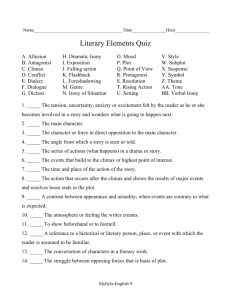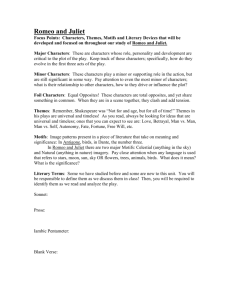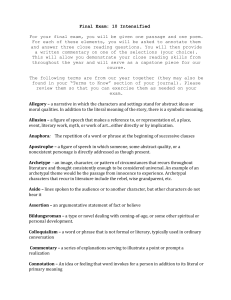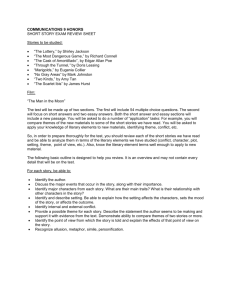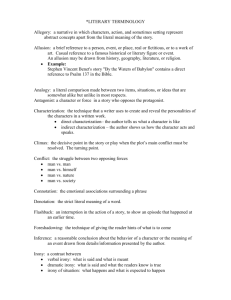LITERARY DEVICES
advertisement
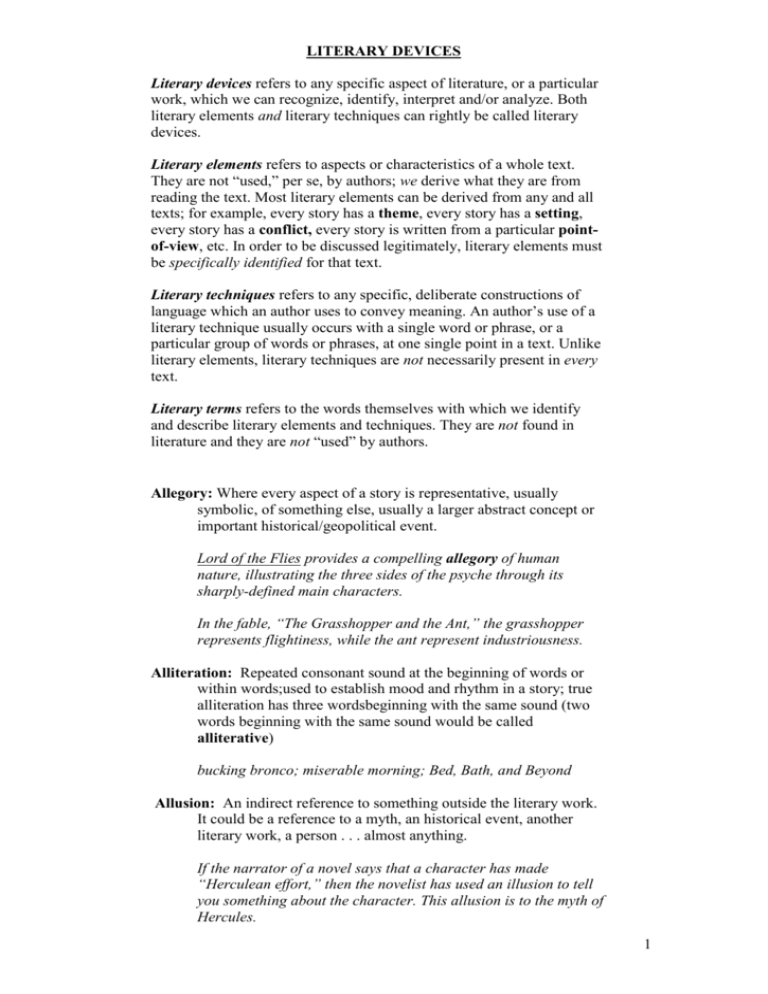
LITERARY DEVICES Literary devices refers to any specific aspect of literature, or a particular work, which we can recognize, identify, interpret and/or analyze. Both literary elements and literary techniques can rightly be called literary devices. Literary elements refers to aspects or characteristics of a whole text. They are not “used,” per se, by authors; we derive what they are from reading the text. Most literary elements can be derived from any and all texts; for example, every story has a theme, every story has a setting, every story has a conflict, every story is written from a particular pointof-view, etc. In order to be discussed legitimately, literary elements must be specifically identified for that text. Literary techniques refers to any specific, deliberate constructions of language which an author uses to convey meaning. An author’s use of a literary technique usually occurs with a single word or phrase, or a particular group of words or phrases, at one single point in a text. Unlike literary elements, literary techniques are not necessarily present in every text. Literary terms refers to the words themselves with which we identify and describe literary elements and techniques. They are not found in literature and they are not “used” by authors. Allegory: Where every aspect of a story is representative, usually symbolic, of something else, usually a larger abstract concept or important historical/geopolitical event. Lord of the Flies provides a compelling allegory of human nature, illustrating the three sides of the psyche through its sharply-defined main characters. In the fable, “The Grasshopper and the Ant,” the grasshopper represents flightiness, while the ant represent industriousness. Alliteration: Repeated consonant sound at the beginning of words or within words;used to establish mood and rhythm in a story; true alliteration has three wordsbeginning with the same sound (two words beginning with the same sound would be called alliterative) bucking bronco; miserable morning; Bed, Bath, and Beyond Allusion: An indirect reference to something outside the literary work. It could be a reference to a myth, an historical event, another literary work, a person . . . almost anything. If the narrator of a novel says that a character has made “Herculean effort,” then the novelist has used an illusion to tell you something about the character. This allusion is to the myth of Hercules. 1 Other examples include: the rise of the baseball team is the real Cinderella story; at times teachers need the wisdom of Solomon to make decisions. Ambiguity: When a single event or expression can mean two different things to two different people When it is announced that another baby is on the way, Father remarks, “That could create some problems.” He means problems with money, but his young son thinks, “You’re right, dad! I don’t want to share my room and toys with anybody!” Analogy: Comparing one thing to another very different thing in order to explain it better A school is like a garden, where children are lovingly raised and cared for; the rabbit shot from its hole like a rocket; the confetti fell like snow in a blizzard as the parade passed through the city streets (these three analogies are all written as similes.) Antagonist: Counterpart to the main character and source of a story’s main conflict. The person may not be “bad” or “evil” by any conventional moral standard, but he/she opposes the protagonist in a significant way. In “Little Red Riding Hood,” the Big Bad Wolf is the antagonist because he is in conflict with Little Red Riding Hood. In Batman, the Joker is the antagonist. Anthropomorphism: Where animals or inanimate objects are portrayed in a story as people, such as by walking, talking, or being given arms, legs and/or facial features. (This technique is often incorrectly called personification.) The King and Queen of Hearts and their playing-card courtiers comprise only one example of Carroll’s extensive use of anthropomorphism in Alice’s Adventures in Wonderland. Aphorism: A brief statement expressing some truth as shown is a story; it can be a moral, or proverb, or maxim. Don’t count your chickens before they’re hatched. Everyone is afraid of something. Don’t make a big fuss if someone isn’t like us. Assonance: Repetition of a vowel sound within or among words, usually within one line of poetry. In this example by Carl Sandburg, in Early Moon, the long “o” sounds old or mysterious. “Poetry is old, ancient, goes back far. It is among the oldest of living things. So old it is that no man knows how and why the first poems came.” 2 Atmosphere: Mood or feeling developed through descriptions of the setting and senses (how things feel, taste, smell, sound, look) Camping in those woods, time went slow. The thick forest air just sat on you, hot and wet like a wool blanket, while mosquitoes droned in your ears and stung you on the back where you could never quite reach to smack them. Blank verse: Non-rhyming poetry, usually written in iambic pentameter. Most of Shakespeare’s dialogue is written in blank verse, though it does occasionally rhyme. Caricature: Exaggeration or distortion of a physical trait or behavior, to make a character appear comic or ridiculous Her nose was needle sharp, with nostrils as small and black as a mouse’s eyes. Characterization: The author’s means of conveying to the reader a character’s personality, life history, values, physical attributes, etc. Also refers directly to a description thereof. In To Kill a Mockingbird, Atticus is characterized as an almost impossibly virtuous man, always doing what is right and imparting impeccable moral values to his children. Circular Story: A story which begins and ends at the same place, usually following a character through different adventures or events; although the character arrives back where he/she started, he or she should now have a different perspective or feeling based upon experiences A poor farmer travels to the city where he observes many expensive buildings and belongings, all owned by the same man. He is jealous of that man until he sees a funeral, and learns that the rich man is dead. Although the man was extremely wealthy, he could enjoy none of that in death. The poor farmer returns home, happy with what little he owns because he is alive to enjoy it. Climax: The turning point in a story, at which the end result becomes inevitable, usually where something suddenly goes terribly wrong; the “dramatic high point” of a story. Romeo and Juliet reaches its climax in Act III, when Mercutio and Tybalt are killed and Romeo is banished from Verona. In “Cinderella,” the clock striking twelve and Cinderella’s rush home before the prince finds out her secret is the climax. 3 Conflict: A struggle between opposing forces which is the driving force of a story. The outcome of any story provides a resolution of the conflict(s); this is what keeps the reader reading. Conflicts can exist between individual characters, between groups of characters, between a character and society, etc., and can also be purely abstract (conflicting ideas). In Romeo and Juliet, the conflict between the Montagues and Capulets causes Romeo and Juliet to behave irrationally once they fall in love. In Lord of the Flies, Jack’s priorities are in conflict with those of Ralph and Piggy, which causes him to break away from the group. Man-versus-nature is an important conflict in The Old Man and the Sea. Context: Facts and conditions surrounding a given situation. In A Tale of Two Cities, Madame Defarge’s actions seem almost reasonable in the context of the Revolution. Creative license: Exaggeration or alteration of objective facts or reality, for the purpose of enhancing meaning in a fictional context. In Animal Farm, Orwell took some creative license with the historical events of the Russian Revolution, in order to clarify the ideological conflicts. Dialogue: Where characters speak to one another; may often be used to substitute for exposition. Since there is so little stage direction in Shakespeare, many of the characters’ thoughts and actions are revealed through dialogue. Dramatic irony: Where the audience or reader is aware of something important, of which the characters in the story are not aware. Shakespeare’s Macbeth responds with disbelief when the weird sisters call him Thane of Cawdor; ironically, unbeknownst to him, he had been granted that title by king Duncan in the previous scene. Exposition: Where an author interrupts a story in order to explain something, usually to provide important background information. The first chapter consists mostly of exposition, running down the family’s history and describing their living conditions. 4 Figurative language: Any use of language where the intended meaning differs from the actual literal meaning of the words themselves. There are many techniques which can rightly be called figurative language, including metaphor, simile, hyperbole, personification, onomatopoeia, verbal irony, and oxymoron. (Related: figure of speech) The poet makes extensive use of figurative language, presenting the speaker’s feelings as colors, sounds and flavors. Flashback: Interruption of the present action to insert an episode that took place earlier; this gives the reader needed information to understand a current event, or a character’s motivation. Examples of flashback in Harry Potter include when Harry was looking into the memories of others through the Pensieve. For example, some memories were of Dumbledore's when he met Tom Riddle for the first time. Foil: A character who is meant to represent characteristics, values, ideas, etc. which are directly and diametrically opposed to those of another character, usually the protagonist. In Macbeth, the noble, virtuous father Macduff provides an ideal foil for the villainous, childless Macbeth. Foreshadowing: Where future events in a story, or perhaps the outcome, are suggested by the author before they happen. Foreshadowing can take many forms and be accomplished in many ways, with varying degrees of subtlety. However, if the outcome is deliberately and explicitly revealed early in a story (such as by the use of a narrator or flashback structure), such information does not constitute foreshadowing. In Death of a Salesman, Willy’s concern for his car foreshadows his eventual means of suicide. In the opening of The Wizard of Oz, set in Kansas, the transformation of Miss Gulch into a witch on a broomstick foreshadows her reappearance as Dorothy's enemy in Oz. Hyperbole: A description which exaggerates. The author uses hyperbole to describe Mr. Smith, calling him “the greatest human being ever to walk the earth.” “I am so hungry I can eat a horse.” Iambic pentameter: Poetry written with each line containing ten syllables, in five repetitions of a two-syllable pattern wherein the pronunciation emphasis is on the second syllable. Shakespeare wrote most of his dialogue in iambic pentameter, often having to adjust the order and nature of words to fit the 5 syllable pattern, thus endowing the language with even greater meaning. Imagery: Language which describes something in detail, using words to substitute for and create sensory stimulation, including visual imagery and sound imagery. Also refers to specific and recurring types of images, such as food imagery and nature imagery. The author’s use of visual imagery is impressive; the reader is able to see the island in all its lush, colorful splendor by reading Golding’s detailed descriptions in Lord of the Flies: The ground beneath them was a bank covered with coarse grass, torn everywhere by the upheavals of fallen trees, scattered with decaying coconuts and palm saplings. Irony (a.k.a. Situational irony): Where an event occurs which is unexpected, and which is in absurd or mocking opposition to what is expected or appropriate. (Note: Most of the situations in the Alanis Morissette song are not ironic at all.) Dramatic irony occurs when the audience or readers knows more than the character who is speaking. Verbal irony occurs when someone says something but means the opposite. In To Kill a Mockingbird, Jem and Scout are saved by Boo Radley, who had ironically been an object of fear and suspicion to them at the beginning of the novel.(Situational) The audience knows Juliet is not dead when Romeo visits her in the catacombs. (Dramatic) “This is going to be fun,” said the boy as he walked into the dentist’s office for a root canal. (Verbal) Metaphor: A direct relationship where one thing or idea substitutes for another. Shakespeare often uses light as a metaphor for Juliet; Romeo refers to her as the sun, as “a rich jewel in an Ethiop’s ear,” and as a solitary dove among crows. Mood: The atmosphere or emotional condition created by the piece, within the setting. The mood of Macbeth is dark, murky and mysterious, creating a sense of fear and uncertainty. Motif: A recurring important idea or image. A motif differs from a theme in that it can be expressed as a single word or fragmentary phrase, while a theme usually must be expressed as a complete sentence. Blood is an important motif in A Tale of Two Cities, appearing numerous times throughout the novel. 6 Motive: A character’s reason for doing what he/she does “So why did you tear up Janie’s paper?” demanded the teacher. Margaret said nothing and stared at her shoes. The teacher would never understand. She could never understand how it felt to be the new kid in school, and to have one student turn all the others against you. All because you... Onomatopoeia: Where sounds are spelled out as words; or, when words describing sounds actually sound like the sounds they describe. In All Quiet on the Western Front, Remarque uses onomatopoeia to suggest the dying soldier’s agony, his last gasp described as a “gurgling rattle.” Oxymoron: A contradiction in terms. In Romeo and Juliet, Romeo describes love using several oxymorons, such as “cold fire,” “feather of lead” and “sick health,” to suggest its contradictory nature. Paradox: Where a situation is created which cannot possibly exist, because different elements of it cancel each other out. In 1984, “doublethink” refers to the paradox where history is changed, and then claimed to have never been changed. A Tale of Two Cities opens with the famous paradox, “It was the best of times, it was the worst of times.” Parallel Story: A narrative or picture story enclosed within another story, where both stories are of equal interest In a story about kids putting on a play, both the onstage scene is shown, and the backstage happenings. In Matrix Reloaded, Neo and Trinity’s plot lines are parallel. Parallelism: Use of similar or identical language, structures, events or ideas in different parts of a text. In The Natural, Hobbs’ final strikeout parallels the Whammer’s striking out against him at the beginning of the novel. Parody: A humorous story that makes fun of another well-known story by imitating it; characters, plot, theme, setting, may all be copied or changed for humorous effect The True Story of the Three Little Pigs by John Scieszka has the story of the Three Little Pigs explained from the wolf’s point of view, and in his version it was all a big misunderstanding and he was innocent. 7 Personification (I): Where inanimate objects or abstract concepts are seemingly endowed with human self-awareness; where human thoughts, actions and perceptions are directly attributed to inanimate objects or abstract ideas. (Not to be confused with anthropomorphism.) In The Natural, Malamud personifies Hobbs’ bat, giving it a name, Wonderboy, referring to it using personal pronouns, and stating that “he went hungry” during Hobbs’ batting slump. Personification (II): Where an abstract concept, such as a particular human behavior or a force of nature, is represented as a person. The Greeks personified natural forces as gods; for example, the god Poseidon was the personification of the sea and its power over man. Plot: Sequence of events in a story. Most literary essay tasks will instruct the writer to “avoid plot summary;” the term is therefore rarely useful for response or critical analysis. When discussing plot, it is generally more useful to consider its structure, rather than simply “what happens.” Plots can be very complex, as in Romeo and Juliet, in which the plot is the course of events leading to the two young lovers’ deaths. Point-of-view: The identity of the narrative voice; the person or entity through whom the reader experiences the story. May be thirdperson (no narrator; omniscient or limited) or first-person (narrated by a character in the story). Point-of-view is a commonly misused term; it does not refer to the author’s (or characters’) feelings, opinions, perspectives, biases, etc. Though it is written in third-person, Animal Farm is told from the point-of-view of the common animals, unaware of what is really happening as the pigs gradually and secretively take over the farm. Writing the story in first-person point-of-view enables the reader to experience the soldier’s fear and uncertainty, limiting the narrative to what only he saw, thought and felt during the battle. Poetic Justice: An outcome in a story where good is rewarded, and evil is punished The wolf is boiled in the pot at the end of the Three Little Pigs; good Cinderella marries the handsome prince; the lazy grasshopper suffers a hungry winter because he did not work hard like the ant to store up food. 8 Protagonist: The main character in a story, the one with whom the reader is meant to identify. The person is not necessarily “good” by any conventional moral standard, but he/she is the person in whose plight the reader is most invested. In The Catcher in the Rye, Holden Caulfield is the protagonist. Pun: a humorous use of a word or phrase that has more than one meaning (or two similarly spelled words that sound alike) “If you really want to keep warm, try bear skin,” said the trapper.“But won’t I be really cold in my bare skin?” asked the boy. Why is it easy for an elephant to travel? He can carry his own trunk. Repetition: Where a specific word, phrase, or structure is repeated several times, to emphasize a particular idea. The repetition of the words “What if…” at the beginning of each line reinforces the speaker’s confusion and fear. Setting: The time and place where a story occurs. The setting can be specific (e.g., New York City in 1930) or ambiguous (e.g., a large urban city during economic hard times). Also refers directly to a description thereof. The novel To Kill a Mockingbird is set in the South during the racially turbulent 1930’s, when blacks were treated unfairly by the courts. With the island in Lord of the Flied, Golding creates a pristine, isolated and uncorrupted setting, in order to show that the boys’ actions result from their own essential nature rather than their environment. Simile: An indirect relationship where one thing or idea is expressed as being similar to another. Similes usually contain the words “like” or “as,” but not always. The simile in line 10 describes the lunar eclipse: “The moon appeared as a large drop of blood.” Speaker: The “voice” of a poem; not to be confused with the poet him/herself. Analogous to the narrator in prose fiction. Structure: The manner in which the various elements of a story are assembled. In The Canterbury Tales, the individual tales are told within the structure of the larger framing story, where the 29 travelers gather at the Inn at Southwark on their journey to Canterbury, telling stories to pass the time. 9 The play follows the traditional Shakespearean five-act plot structure, with exposition in Act I, development in Act II, the climax or turning point in Act III, falling action in Act IV, and resolution in Act V. Symbolism: The use of specific objects or images to represent abstract ideas. This term is commonly misused, describing any and all representational relationships, which in fact are more often metaphorical than symbolic. A symbol must be something tangible or visible, while the idea it symbolizes must be something abstract or universal. In Lord of the Flies, Golding uses symbols to represent the various aspects of human nature and civilization as they are revealed in the novel. The conch symbolizes order and authority, while its gradual deterioration and ultimate destruction metaphorically represent the boys’ collective downfall. Theme: The main idea or message conveyed by the piece. A theme is generally stated as a complete sentence; an idea expressed as a single word or fragmentary phrase is a motif. In Animal Farm, George Orwell’s theme is that absolute power corrupts absolutely. The idea that human beings are essentially brutal, savage creatures provides the central theme of Lord of the Flies. Tone: The apparent emotional state, or “attitude,” of the speaker/narrator/narrative voice, as conveyed through the language of the piece. The poem has a bitter and sardonic tone, revealing the speaker’s anger and resentment. In Gulliver’s Travels, the tone of Gulliver’s narration is unusually matter-of-fact, as he seems to regard these bizarre and absurd occurrences as ordinary or commonplace. Tragedy: Where a story ends with a negative or unfortunate outcome which was essentially avoidable, usually caused by a flaw in the central character’s personality. Tragedy is really more of a dramatic genre than a literary element; a play can be referred to as a tragedy, but tragic events in a story are essentially part of the plot, rather than a literary device in themselves. Tragic hero/tragic figure: A protagonist who comes to a bad end as a result of his own behavior, usually cased by a specific personality disorder or character flaw. In Death of a Salesman, Willy Loman is one of the best-known tragic figures in American literature, oblivious to and unable to face the reality of his life. 10 Tragic flaw: The single characteristic (usually negative) or personality disorder which causes the downfall of the protagonist. Othello’s tragic flaw is his jealousy, which consumes him so thoroughly that he is driven to murder his wife rather than accept, let alone confirm, her infidelity. Understatement: When the author presents something as less significant (important) than it really is Mr. Brumble looked at both test papers, back and forth, back and forth, noting that all the answers were exactly the same. He put the papers down on his desk, crossed his arms and said, “Boys, we have a little problem here.” Verbal irony: Where the meaning is intended to be the exact opposite of what the words actually mean. (Sarcasm is a tone of voice that often accompanies verbal irony, but they are not the same thing.) In 1984, Orwell gives this torture and brainwashing facility the ironic title, “Ministry of Love.” Reference Sources: http://mrbraiman.home.att.net/lit.htm http://teachingreadingandla.pbworks.com/f/Literary+Devices.pdf 11

